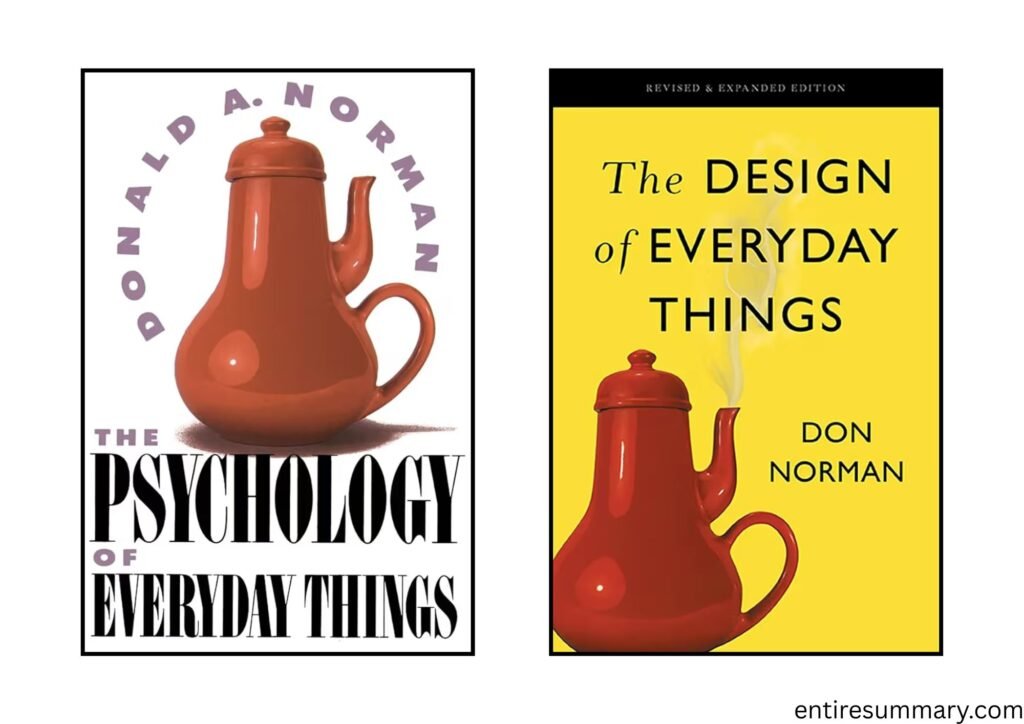Donald Norman’s classic book, The Psychology of Everyday Things, is a foundational text about design, usability, and how people interact with the world around them. Originally published in 1988, The Psychology of Everyday Things explains why so many everyday objects frustrate us and how better design can make our lives easier. Written in an engaging, story-driven style, Norman bridges psychology and product design, showing how simple changes can help people interact with objects more naturally.
First Half Summary: Key Concepts and Themes
Norman opens The Psychology of Everyday Things with the idea that bad design isn’t the user’s fault—it’s the designer’s. Everyday frustrations, from doors that don’t open the way we expect to confusing remote controls, stem from poor design choices. He lays out principles that explain how people interact with objects.
The User is Not to Blame
- When someone struggles with an object, the fault is usually with design, not intelligence.
- Great design should make it obvious how to use an item, eliminating the need for directions.
Affordances and Signifiers
- Affordances are the possibilities for action. For example, a chair affords sitting, while a handle affords pulling.
- Signifiers are clues that tell users how to use something—like a “push” sign on a door.
- Norman stresses that visible, clear signifiers reduce confusion.
Also read: /the-interpretation-of-dreams/
The Gulf of Execution and Evaluation
- Norman describes two psychological “gulfs” in using objects:
- Execution: figuring out what actions are possible and how to perform them.
- Evaluation: understanding what happened and whether the action succeeded.
- Good design minimizes both gaps by making actions intuitive and feedback immediate.
Feedback is Crucial
- Users need to know when an action has been completed.
- A light turning on, a sound, or a physical click are forms of feedback.
- Lack of feedback leads to frustration, errors, or repeated unnecessary actions.
Constraints Simplify Choices
- Constraints guide behavior by limiting possible actions.
- Physical constraints (a plug fitting only one way), logical constraints (a puzzle piece that fits in one spot), and cultural constraints (red means stop) all reduce error.
- Constraints are essential for intuitive design.
Everyday Design Fails
- Norman highlights examples such as confusing light switches, poorly labeled faucets, and error-prone electronics.
- These examples show how design can unintentionally create stress in daily life.

Second Half Summary: Broader Lessons and Applications
The second half of the book shifts from diagnosing problems to proposing solutions and broader implications for design.
The Power of Conceptual Models
- A conceptual model is the mental picture a person has of how a device or system operates. It’s the user’s internal understanding of the product, often based on their past experiences and assumptions, which guides how they interact with it.
- If the model is accurate and simple, people succeed. If it’s misleading, they fail.
- Designers must create products that support clear mental models.
Human Error and Design
- Norman disagrees with the idea that mistakes are entirely the user’s fault.
- Most errors are design errors because the object invites mistakes.
- He identifies two main types:
- Slips: doing the wrong action when intending the right one.
- Mistakes: having the wrong goal or plan.
- Good design anticipates these errors and minimizes consequences.
Natural Mapping
- Mapping refers to the relationship between controls and their effects.
- Good mapping makes actions obvious—for example, stove burners aligned with their corresponding knobs.
- Poor mapping (random placement of controls) leads to frequent errors.
Visibility and Simplicity
- When a function is more visible and obvious, it becomes easier to use.
- Hiding controls or overcomplicating layouts confuses users.
- Simplicity is not about fewer features but about making features understandable.
Design for Different Users
- People have varying levels of experience, so design should accommodate both beginners and experts.
- Norman advocates for forgiving design—systems that allow recovery from errors instead of punishing users.
Everyday Psychology Applied to Technology
- The book concludes by extending these lessons to emerging technologies.
- Norman argues that as systems get more complex, intuitive design is more important, not less.
- He urges designers to remember that real people—not engineers—use their products daily.

Key Takeaways
- Bad design creates frustration. Most user errors are actually design errors.
- Affordances and signifiers guide behavior. Good design makes intended actions obvious.
- Feedback builds confidence. Users should always know what action occurred.
- Constraints prevent mistakes. Limiting wrong choices leads to easier use.
- Design should respect psychology. Objects must align with how people think and behave, not force users to adapt.
FAQs about The Psychology of Everyday Things
Concept and Theory Questions
What is the main idea of the book?
Norman argues that design should prioritize human psychology, making everyday objects easy and intuitive to use.
What does Norman mean by “affordances”?
Affordances are the potential uses of an object. A button is designed to be pressed, while a handle is designed to be pulled. Good design highlights these affordances clearly.
How does Norman explain human error?
He suggests that most so-called “human errors” are really design flaws. People fail because objects are confusing, not because they are incompetent.
Application Questions
Can I apply these lessons to digital products?
Absolutely. Principles like feedback, mapping, and visibility apply equally to apps, websites, and physical devices.
How does this book help designers?
It provides practical guidelines to create user-friendly products while reminding designers to put people—not technology—at the center.
Fun and Thought-Provoking Questions
Why does the book use so many everyday examples?
Because Norman wants readers to recognize poor design in their own lives, from doors to switches, and understand how psychology explains the frustration.
Is this book still relevant today?
Yes. Even decades later, its lessons apply to smartphones, cars, appliances, and websites. In fact, with technology more complex than ever, the principles are even more essential.
Final Thoughts
The Psychology of Everyday Things is a must-read for anyone interested in design, usability, or human behavior. Donald Norman’s approachable style makes complex psychology easy to understand, while his examples remind us that design failures surround us daily. The book encourages us to demand better products and challenges designers to put people first.

